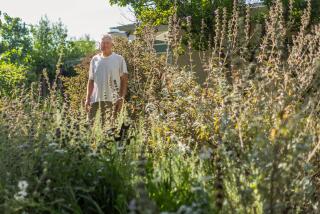Business Blossoms at Succulents Nursery : Gardening: Devotion to water-thrifty plants gave couple’s operation a low profile--until the drought.
- Share via
For more than 20 years, Manny and Bert Singer have been the oddballs of the local garden nursery trade. This husband-and-wife team do not stock roses, geraniums, azaleas or any other popular flowers. Theirs is not the place to go for soft ground covers, leafy vegetables or ceramic bird feeders.
Singers’ Growing Things in Northridge sells almost nothing but a type of succulent that has a caudex, a swollen area near the base where water and other nutrients are stored. These plants--native to Madagascar and South Africa and to parts of Central and South America--are not, at first glance, friendly plants. Many are spiny, sharp-leaved, spare or otherwise forbidding.
“We love them,” said Manny, 72, a rotund, friendly man. “They take so many unusual forms. The weirder they are, the more we like them.
“I think of them as sculpture.”
Sculpture was not what the rest of the gardening world craved. Although Manny and Bert’s shop had its fans who mailed in orders from all over the country, the Singers’ operation was relatively anonymous.
Until the drought.
Suddenly, a plant that could store water for long periods of time was attractive no matter how spiny.
“I’d say our business is up about 30% over the last year,” said Manny, standing in the middle of their three-quarter acre nursery on a side street near Cal State Northridge. “Landscape architects and other people looking for things for the yard have suddenly found us out here.”
Manny didn’t start out to be the caudex king of Northridge. He trained as a mechanical engineer and worked in that profession until the early 1970s. But he had inherited a love for exotic botanical forms from his father, who was an ardent and adventurous gardener. “I still have some of his plants,” Manny said.
He and his wife, Bert, who was working as a gerontologist at a Jewish senior center, decided to turn his hobby into a business. Then living in Reseda with no room for a large garden, they grew their succulents in a plot they had in Vista, near Oceanside in San Diego County.
“I would go there every week to tend to things,” Manny said. He also traveled extensively in Africa and Central and South America to find succulents that he could bring back and propagate or grow by seed.
“We have not imported anything since 1972 because many of the succulents were declared endangered species,” he said. “Countries will not allow them to be taken out.
“We do all our own growing now.”
They had little need to do more importing. By 1979, when they moved to Northridge, they had almost half a million plants.
Even though their hobby evolved into their livelihood, they don’t look upon their wares as mere products.
“Where is my deer?” asked Bert, 72, looking along a long line of succulents on a shelf in their greenhouse. The shelves, full of especially exotic-looking caudex plants, were marked “Not for Sale.”
“Some of these are very, very old,” said Bert, explaining that a few are more than 50 years old. Some have endearing shapes, such as a small Cissus tuberosa she points out as looking, with a bit of imagination, like a deer.
“It would be hard to part with these,” she said.
Some plants in the greenhouse are rare. Their Baroni is one of the very few in existence outside its native Madagascar. “They are restricted now and so if someone gets it out, it’s smuggled and we won’t deal in smuggled goods,” Bert said.
The Singers have one grown from seed that is about 18 inches tall. If it were for sale, the price tag would be close to $3,000, Manny said.
The most popular plants they have at the moment are, not surprisingly, ones that have at least a bit of color in addition to green. The Euphorbia milii , for example, is a hybrid that has flowers in various shades of red and yellow. After flowering, the Busera microphylla from Mexico produces seed pods that look like red berries.
Their most popular plants retail for as low as $4 to about $200, depending on the size and rarity.
Like Manny’s father before him, Manny and his wife have passed on their love of plants to their daughter, Lili of Van Nuys.
“I was an English major in college,” said Lili, who eventually gave in to her heritage. She now is host of the weekly call-in “Garden Show” heard at 1:30 p.m. Fridays on KCRW-FM radio. This fall, she will begin publishing a bimonthly newsletter specifically for Southern California gardeners.
Lili welcomes the new interest in succulents and battles the stereotypes associated with them.
“Because of the cactus, people think that succulents are all thorny,” she said. “But it is a misconception. Some of them are actually ‘touch me’ plants.”
Lili, who worked for a time for her parents in the gardening business, learned that firsthand.
“My father has a customer who is blind,” she said. “This man loves succulents and he really works with them. He does it all by texture and feel.”
Ironically, just as the world was finally beating a path to their door, the Singers were looking forward to slowing down. In the last year, they have sold off much of their stock to other nurseries. Their inventory is about 75,000 plants.
“We’re certainly going to still be in business for a while,” Manny said as he headed back to the greenhouse to do a bit of propagating. “But it was getting to be overbearing.”
“It seems we have as much work as ever,” Bert said with a laugh. “The orders just keep coming in.
“We are trying to slow down a bit, but it’s hard when there is so much interest in what we are doing.”







